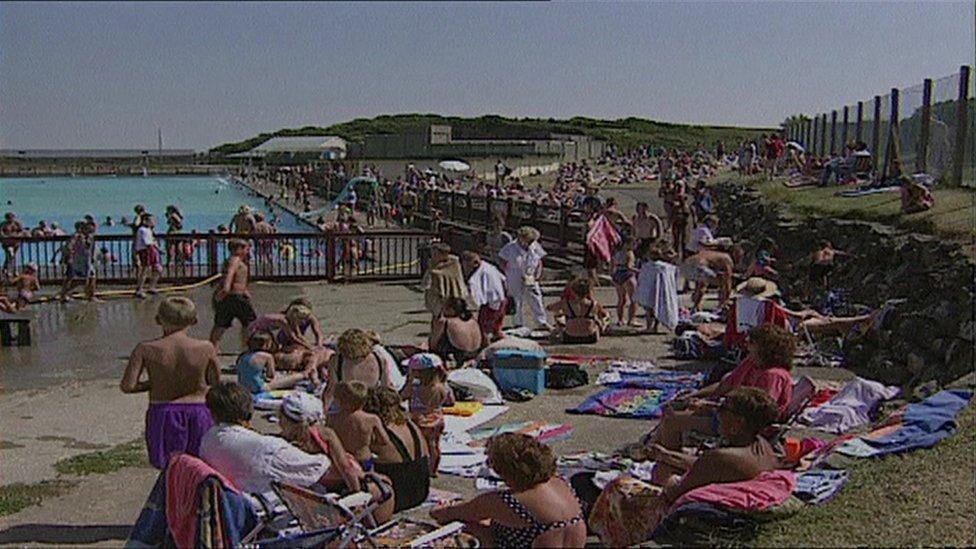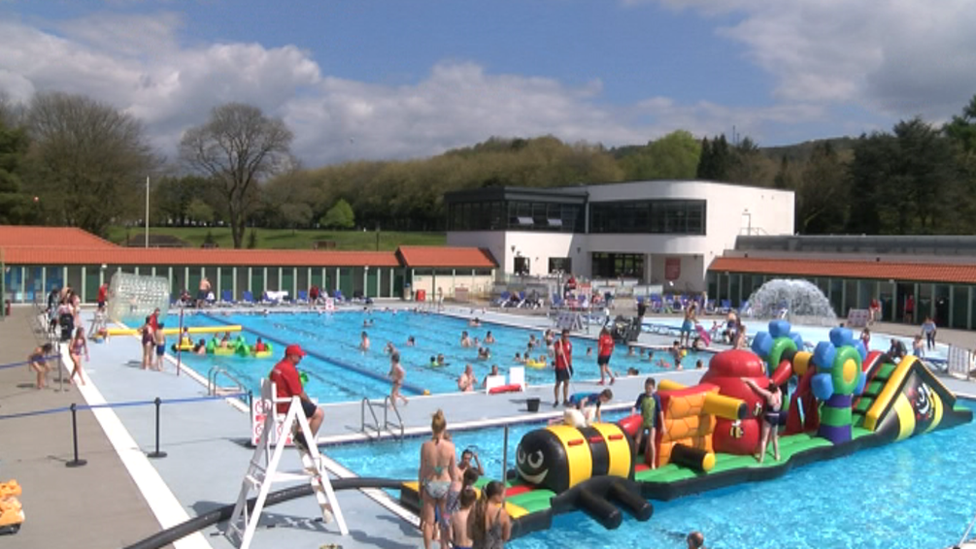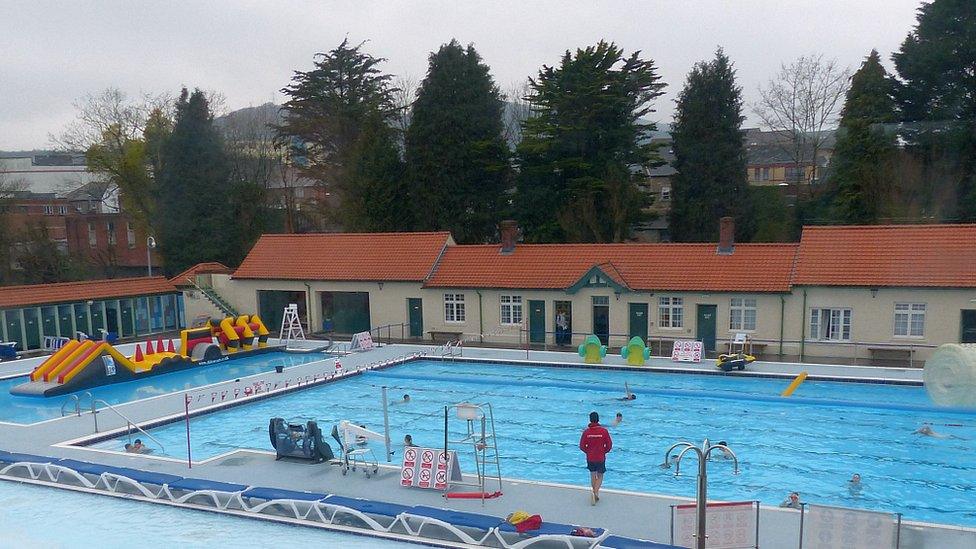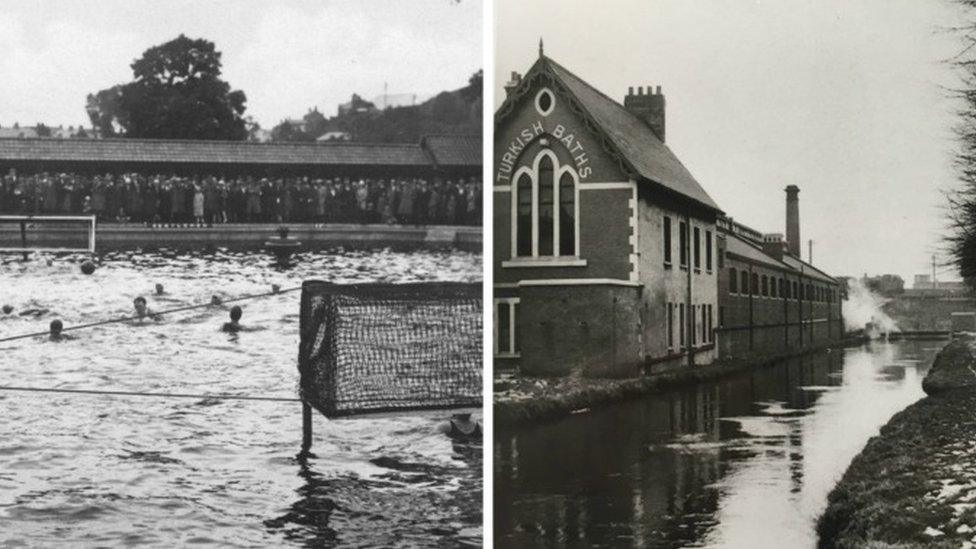Outdoor swimming in Wales: Are lidos making a comeback?
- Published

Lidos, including in Barry, pictured in 1995, were very popular until travelling abroad became cheaper and more accessible
Lidos became the staple of a 19th Century summer's day - but are they making a comeback after falling out of favour?
With a record-breaking summer at Wales' only lido in Pontypridd, Abergavenny Lido Group are aiming to raise enough money to build one in the town.
The Monmouthshire group said there was a "great deal of enthusiasm" to bring back outdoor swimming spaces.
Historian Daryl Leeworthy said the enthusiasm "comes in waves".
At one time there were more than 57 outdoor pools in Wales. Now there is just one, the National Lido of Wales in Pontypridd, Rhondda Cynon Taf.
The Grade II-listed Lido Ponty, set in Ynysangharad War Memorial Park, reopened in 2015 after a £6.3m revamp.
But the Pontypridd pool needed extensive repairs after Storm Dennis brought a month's worth of rain in 48 hours in February 2020.
Due to Covid restrictions, it also had to close for over a year.
Do people really want to go to lidos?

Lido Ponty had a record-breaking summer this year
The answer is "absolutely", according to Brent Bennett, operations manager at Ponty Lido.
Mr Bennett said the facility had been "hugely popular" since reopening because more people wanted to exercise outside due to Covid.
"We got around 75,000 visitors in 2018, which was a particularly hot and sunny season, and now we're just over 92,000 visitors," he explained.
"We've shortened our sessions to allow more people to have an opportunity so they are not turned away.
"Obviously, when people have been stuck indoors, when they then open the floodgates... it's been once again very popular."

Lido Ponty reopened in 2015 after a £6.3m revamp
Mr Bennett said he believed people have been increasingly turning to outdoor exercise in recent years, even before the pandemic, so was not surprised the lido, which has a 17-week season, had a record-breaking summer.
"It could be quite freezing cold but behind the walls you could be anywhere in the world," he said.
"If you just looked up in the mountains in the greenery, it could be absolutely anywhere, and you know, is fantastic."
He said if projects could find the money, lidos would thrive in other areas too and attract visitors.
Where else could we see lidos in Wales?

The Abergavenny Lido Group say they are getting a lot of support from the community
The Abergavenny Lido Group are looking to fund a feasibility study to assess the viability of a project - the first step towards funding for a lido.
The original pool opened in 1938 and was demolished a decade after it closed in 1996.
The planned lido would be powered by renewable energy and built on the site of the former pool at Bailey Park.
Bailey Park Pool
Chairman George Foster said the group had been inundated with support on social media due to a "huge resurgence" of interest in swimming outdoors during lockdown.
Mr Foster said "an awful lot of people" had fond memories of being at the old lido during the summer months.
"It could be a real asset for the town, great tourist attraction and also something that people can be proud of," he added.
"The town really needs a lift, like any other towns do after the pandemic, and this is something that we feel an awful lot of people will continue to support."

Swimmers enjoy the open air pool in Bailey Park in 1972
Monmouthshire council, which owns the land, previously granted the lido group consent to carry out fundraising activities, such as applying for grants, but said it would be unable to provide further financial support.
A previous estimate said it would cost about £7m to rebuild the outdoor pool.
What have lidos in Wales looked like over the years?

The Pontypridd Lido opened in 1927 and Cardiff's Guildford Crescent pool was said to be Wales' oldest
Mr Leeworthy, a historian at Swansea University, said a resurgence of love for lidos in Wales is not unusual, and that it comes in "waves of popularity".
"In the 1920s, they were brand new facilities for communities to use," he said.
"The growth of swimming in the 1950s was helped by the popularity of open air swimmers and big races taking place around the world, and in the 1970s they were massively helped by the sports councils."
But once package holidays became cheaper and more accessible, Mr Leeworthy said holidays in often colder and wetter Wales "lost its appeal".

The Brynmawr pool in Blaenau Gwent was built by the International Voluntary Service
Mr Leeworthy said nostalgia could be driving the resurgence.
In north Wales, many were introduced in the 1920s and 1930s to "give an extra" to seaside towns.
But in the south, particularly in the valleys, many were introduced as a consequence of the Miners' Welfare Fund and "a desire to have open air, leisure facilities".
The aim of the fund was to provide facilities in coalfield areas to help make them "less riotous", Mr Leeworthy explained.
He added: "So the swimming pools and recreation grounds that were built were very much a demand from communities themselves."

HAYLEY PEARCE PODCAST : Tackling the issues that make your group chats go off
COMING OUT: From secrets to social media, conversations from the LGBTQ+ community in Wales

- Published9 April 2021

- Published25 May 2021

- Published7 August 2017

- Attribution
- Published14 September 2021

- Published4 October 2021
